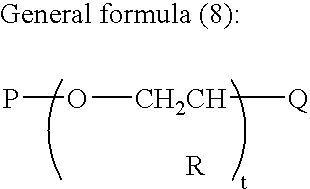Conjugated diene rubber, process for producing the same, and rubber composition
a technology of conjugated diene rubber and rubber composition, which is applied in the direction of transportation and packaging, tyre parts, special tyres, etc., can solve the problems of poor processability of vulcanizable rubber compositions having silica incorporated therein, poor poor processability. , to achieve the effect of well-balanced reduction of heat build-up and wet grip performance, poor abrasion resistan
- Summary
- Abstract
- Description
- Claims
- Application Information
AI Technical Summary
Benefits of technology
Problems solved by technology
Method used
Image
Examples
example 1
[0169]An autoclave equipped with a stirrer was charged with 6,000 g of cyclohexane, 150 g of styrene, 450 g of 1,3-butadiene, and tetramethylethylenediamine in an amount of 1.5 times by mole of n-butyllithium used. Then, 9.5 milli-moles of n-butyllithium was added to initiate polymerization at 50° C. When 20 minutes elapsed from the initiation of polymerization, a mixture of 60 g of styrene and 340 g of 1,3-butadiene was continuously added over a period of 60 minutes. The highest temperature reached during polymerization was 70° C.
[0170]After completion of the continuous addition, polymerization was further continued for 40 minutes. After confirmation of the fact that the polymerization conversion reached 100%, a small amount of a polymer solution was sampled. An excessive amount of methanol was added to the polymer solution sample to stop the reaction. The polymer was air-dried to recover a polymer specimen for analysis by gel permeation chromatography.
[0171]Immediately after the s...
example 8
[0189]An autoclave equipped with a stirrer was charged with 6,000 g of cyclohexane, 160 g of styrene, 440 g of 1,3-butadiene, and tetramethylethylenediamine in an amount of 1.4 times by mole of n-butyllithium used. Then, 9.4 milli-moles of n-butyllithium was added to initiate polymerization at 50° C. When 20 minutes elapsed from the initiation of polymerization, a mixture of 70 g of styrene and 330 g of 1,3-butadiene was continuously added over a period of 60 minutes. The highest temperature reached during polymerization was 70° C.
[0190]After completion of the continuous addition, polymerization was further continued for 40 minutes. After confirmation of the fact that the polymerization conversion reached 100%, a small amount of a polymer solution was sampled. An excessive amount of methanol was added to the polymer solution sample to stop the reaction. The polymer was air-dried to recover a polymer specimen for analysis by gel permeation chromatography.
[0191]Immediately after the s...
examples 9 and 10
[0197]Conjugated diene rubbers XII and XIII were prepared by the same procedures as described in Example 8 except that, after the confirmation of the fact that the polymerization conversion reached 100%, polyorganosiloxane J was added in amounts shown in Table 2, and the amount of n-butyllithium used was changed so that conjugated diene rubbers having a Mooney viscosity shown in Table 2 were obtained. All other conditions remained the same. The properties of conjugated diene rubbers XII and XIII were evaluated. The results are shown in Table 2.
[0198]Rubber compositions were prepared by the same procedures as described in Example 8 except for using conjugated diene rubbers XII and XIII instead of conjugated diene rubber XI. Processability of uncrosslinked rubber compositions and properties of crosslinked rubbers were evaluated. The results are shown in Table 2.
[0199]Comparative Example 4
[0200]Conjugated diene rubber XIV was prepared by the same procedures as described in Example 8 ex...
PUM
| Property | Measurement | Unit |
|---|---|---|
| temperature | aaaaa | aaaaa |
| temperature | aaaaa | aaaaa |
| temperature | aaaaa | aaaaa |
Abstract
Description
Claims
Application Information
 Login to View More
Login to View More - R&D
- Intellectual Property
- Life Sciences
- Materials
- Tech Scout
- Unparalleled Data Quality
- Higher Quality Content
- 60% Fewer Hallucinations
Browse by: Latest US Patents, China's latest patents, Technical Efficacy Thesaurus, Application Domain, Technology Topic, Popular Technical Reports.
© 2025 PatSnap. All rights reserved.Legal|Privacy policy|Modern Slavery Act Transparency Statement|Sitemap|About US| Contact US: help@patsnap.com



